Hot town, for sure. Summer in the city these days means experiencing a different type of island life—heat islands. Decades of intense and short-sighted development in cities such as Baltimore have left areas of our urban centers so filled with impervious surfaces such as asphalt, roofs, and driveways that temperatures skyrocket.
In Baltimore, this means parts of the city lacking trees and other vegetation can reach temperatures as much as 20 degrees higher than neighboring areas that have these natural features. For example, on one of the hottest days during the summer of 2019, scientists recorded 87-degree temperatures around the tree-lined streets in the North Baltimore neighborhood of Ten Hills, while the residential neighborhoods of townhomes in downtown East Baltimore with no yards and little tree cover experienced temperatures as high as 103 degrees, according to the New York Times.

The new concrete cutter that Baltimore Tree Trust uses to create tree wells in impervious surfaces. The Trust used the cutter recently to add 25 new tree wells in the Broadway East neighborhood of Baltimore.
Baltimore Tree Trust
As climate change accelerates, these temperature differences are growing and often leaving under-resourced and largely low-income communities harmed by dangerous heat. The extensive use of impervious surfaces in cities also causes additional polluted water runoff, a problem exacerbated by stronger storms bringing more rain in shorter periods due to climate change.
In response, government officials and nonprofit groups are working to address these issues by adding trees and other green spaces to cities. Scientific studies have shown that adding more tree canopy in cities significantly reduces temperatures in neighborhoods affected by heat islands. The trees also help reduce flooding and filter polluted runoff.
In Baltimore, staff members with the Baltimore Tree Trust work with the city and residents to plant trees. Since the organization's founding in 2008, the group has planted more than 16,000 trees throughout the city, according to Ryan Alston, the communications and outreach manager for the Trust.
"We identify areas of the city that don't have tree cover and then go into the community, locate the neighbors, and identify spots where they support trees being planted," Alston said. "We also work to educate residents and let them know why we're bringing trees to them and how the new trees will help with shade cooling, reduce energy bills, improve air quality, and even how tree infrastructure in a community is linked to lower crime rates."

Baltimore Tree Trust staff deliver the 16 trees to be planted around the school campus at Dickey Hill Elementary School in Baltimore.
Baltimore Tree Trust
Alston emphasized the importance of the education piece because some residents oppose new tree plantings due to concerns about trees uprooting sidewalks or other issues. The organization uses species such as red maples, swamp white oak, sweetgum varieties and others that staff have had success sustainably growing in the city.
Baltimore Tree Trust's work is primarily funded through grants and a partnership with Baltimore City, but a new Maryland law may soon add more support for the organization and others interested in doing similar work.
In 2021, the Maryland General Assembly passed a law requiring the state to plant 5 million new trees by 2030, including 500,000 trees in urban areas. At the time, Chesapeake Bay Foundation staff worked with a coalition of environmental organizations to build support for the effort and help get the legislation approved.
To support the urban tree planting effort, the state budgeted $10 million per year to provide grants to community organizations, nonprofits, churches, and other groups interested in doing the work. Each year, the Chesapeake Bay Trust will solicit grant applications and then award the funding to urban tree planting projects after a review process.
The Trust received $14 million in grant requests in the first year of the program, according to Greg Burks, the Urban Trees Program manager.
"We were very thrilled to see those numbers," Burks said. "We thought, 'wow, there really is a need and this legislation has a place.'"
Burks added that this month the Trust plans to notify 33 different organizations who will receive awards ranging from $1.9 million to $9,000. The projects range from organizations reforesting areas connected to parks to workforce development projects to help people of color get trees in their communities.
"These grants are all community-led and community-driven," Burks said. "When communities have buy-in, then they're more inclined to take care of these trees and love them. The proposals were thoughtful and creative. The people that applied really want to make an impact and do it in a way that's sustainable and benefits their communities for years and years to come."

Baltimore Tree Trust staff work to plant trees at Dickey Hill Elementary School in Baltimore. Staff planted 16 trees around the school campus.
Baltimore Tree Trust
He said several of the projects were focused on cooling neighborhoods that suffer from heat islands. The urban tree planting applications came from all areas around Maryland, except for the Eastern Shore, according to Burks. He said that while parts of the Shore are eligible for urban plantings, the Trust didn't receive any proposals. He's hoping groups from that part of Maryland apply in future years.
For the Baltimore Tree Trust, the increased funding for the organization's work from the state and Baltimore city in recent years is enabling them to expand their operations. Last year, Alston said their organization bought a large concrete cutting saw to help them remove impervious surface to make room for tree pits. This fall they'll be planting trees in Baltimore neighborhoods such as Harlem Park, Seton Hill, Franklin Square, and Broadway East.
"We want to connect residents to the forestry field, encourage them to support new tree plantings through education, and create new jobs—that's really what our initiatives are about," Alston said.

Issues in this Post
Trees Climate Change Community Environmental Justice Restoration Runoff Pollution Trees



